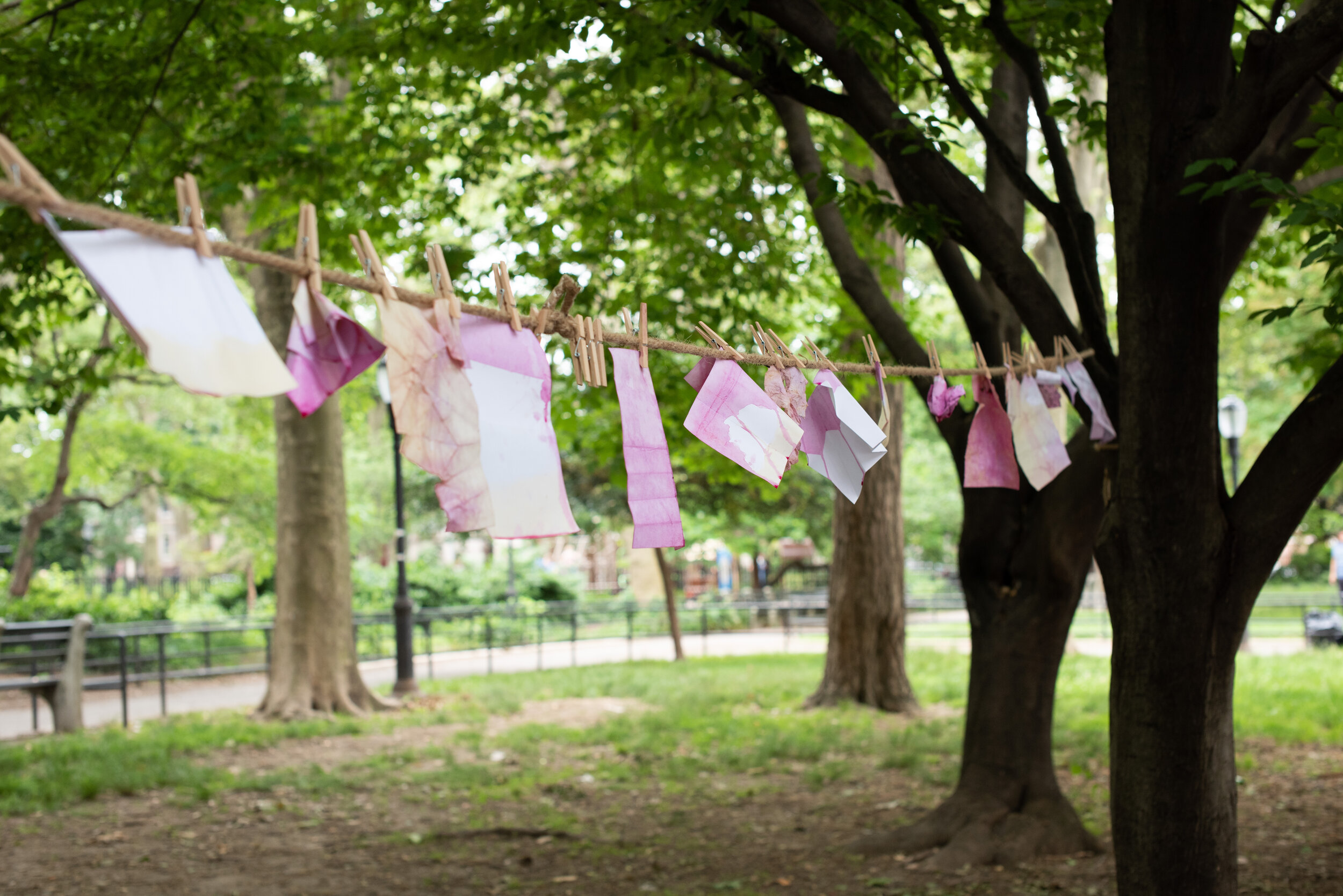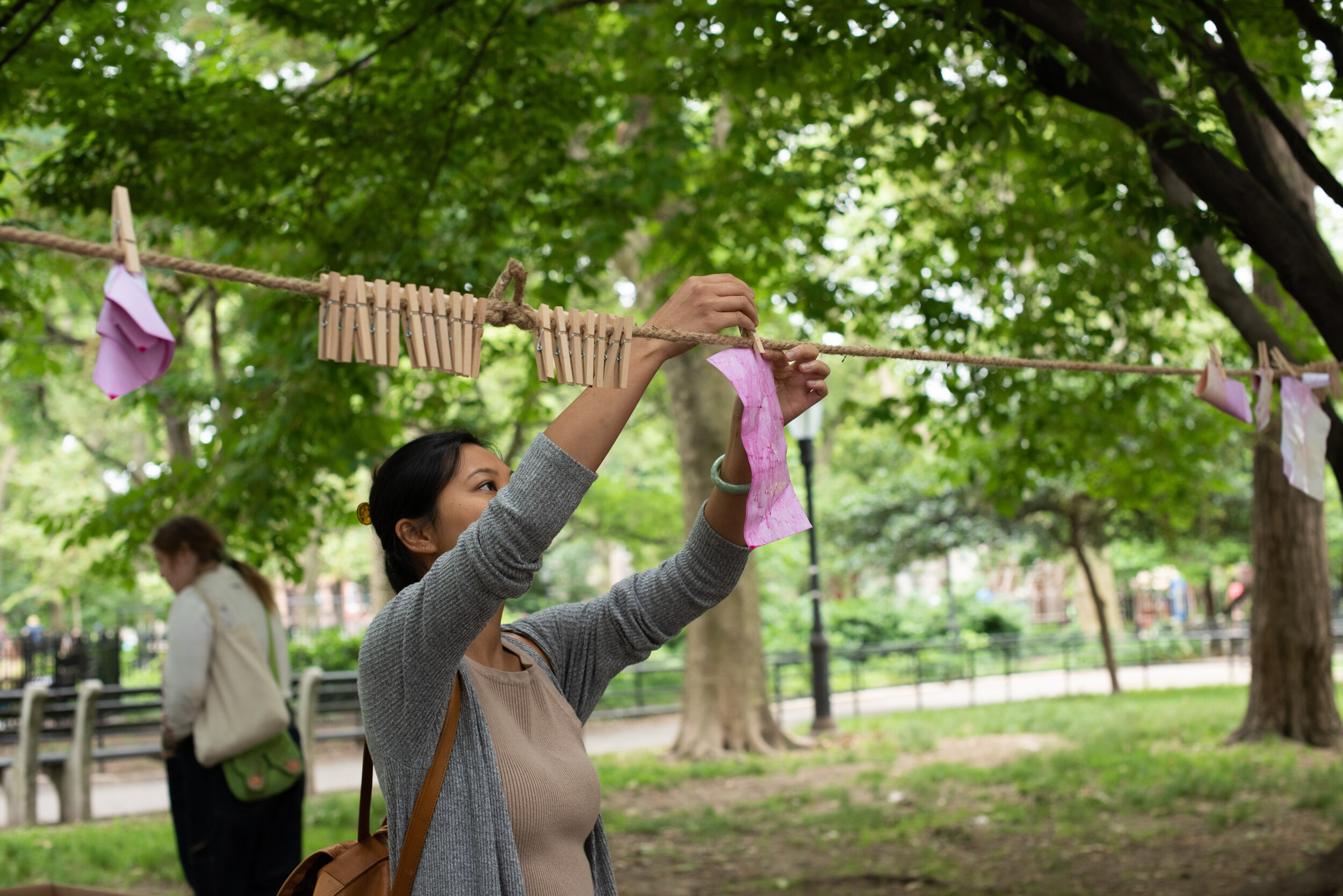THE CURRICULUM
We at Flower Shop Collective are excited to announce Slow Process Summer, a curriculum aimed at gathering and educating artists and non-artists alike in order to give them the tools they need to embrace the idea of community, think about their creative processes through various theoretical lenses, and create more intentional artistic practices. This past year of quarantining and social distancing has made the importance of collective care extremely evident, so we are committed to bringing the creative community together in a way that we hope is empowering. The summer will be full of in-person workshops and virtual discussions highlighting how we can incorporate slow processes across various artistic mediums: natural dyeing techniques, poetry, painting and sculpture. By centering the idea of the slow process, we will show how incorporating archival research, personal histories, and creating handcrafted materials are incredibly rewarding practices.
PAINTING AND SCULPTURE
Symbolism and Iconography
The second segment of Slow Process Summer will center around sculpture and painting, two mediums that are dear to our hearts here at Flower Shop Collective.
Iconography and religious symbolism are visual representations we often use to signal our identities to others. It could signal the culture you grew up in, the spirituality you currently practice, or a connection you have with your ancestors. ‘Symbol’ comes from the Greek ‘symbolon’ which was essentially a means of identification; ‘as a rule, it is based on the convention of a group that agrees upon its meaning’ (Britannica).
Symbolism thus veils and unveils, creating a safe, insular community as well as communicating that community to others. Here at Flower Shop Collective, a majority of our artists work with symbolism to either ground themselves in their communities or to challenge certain aspects of their communities.
Angel Leizelle, an FSC visual artist, often uses what she calls ‘portals’ or ‘an alchemy of the supreme elements’ to convey her message of ‘transcending inner depths’.
FSC painter Steph Butchko talks with LUMXN magazine about her own journey with symbolism through her own paintings; you can watch that here.
Another of our artists, Cesar Kastro, has begun a sculptural project centered around Pre-Hispanic objects that are circulated through private auction houses. Scroll down to get into more of the insidious history of art collecting.
The next three in-person events center iconography and spirituality; they all take place in Brooklyn, and we hope to see you there!
Community Partnership
Flower Shop Collective x The Other Art Fair
OUR MYTHS INTO OUR FUTURES - OTHER ART FAIR
JULY 22-25
We are so excited to be community partners with this year’s The Other Art Fair! We will be exhibiting a live installation entitled ‘Our Myths Into Our Futures’.
‘Our Myths Into Our Futures’ is an installation by the artists of Brooklyn-based Flower Shop Collective. Written across the walls in black and white will be their living artist’s manifesto, which encourages artists to ‘engage in collective care as cultural practice’. Throughout the fair, color will be added as several FSC artists draw from their ancestral and future realities to complete the mural piece-by-piece: a physical embodiment of community. Flower Shop Collective remains in service to artists of color, and they remain determined to cultivate stories of diaspora and home, wherever home may be.
IRL WORKSHOP
REFLECTIVE TRANSPARENCIES
July 30th @ 8:30 PM
In this meditative workshop, video artist Angel Leizelle will take attendees through a kaleidoscopic, spiritual journey. Angel will screen her short film “Skydiving” and walk the viewers through the history of experimental video art as well as describe her process of translating emotional frequencies into an artistic practice. After the screening, attendees will then be able to collaborate with Angel by using a video synthesizer to alter the film they just watched in order to channel their higher emotional frequencies. An entirely new creative piece will be made that encapsulates that moment for each individual. This workshop will take place at FSC HQ in Greenpoint, therefore it will have a limited capacity of 15 people. Because this is a limited capacity event, we will be charging $10 per ticket for accountability purposes. Doors open at 8, screening will begin promptly at 8:30. Drinks will be available for purchase.
a celebration!
ALTARPIECE TO THE ORIGINAL CARETAKERS - August 21 7:00 PM
Join us for an evening of celebration as we welcome the public to our Greenpoint headquarters for the first time! We will be showcasing artist Steph Butchko’s triptych painting entitled ‘Altarpiece to the Original Caretakers”. This is a free event, and a great opportunity to see our studio space and interact with some of our artists. Doors will open at 7 and drinks will be available for purchase.
Materialism and imperialism
When you think of a painting, you most likely think of colors that make up an image. There is one color in particular ‘that has made and felled kings and empires’ (St. Claire): carmine red. This hue is made from crushed cochineal, an insect that feeds off the prickly pear cacti of Mexico and South America. In order to turn cochineal into a red pigment, you need the dried insects, a mordant, and other additives such as acids or metals.
The history of cochineal is a dark one: it was used as a pigment and dye in Central and South America from at least the second century BC, and was integral to the Aztec and Inca empires.
According to Kassia St. Claire, it was also used to signal personal power in the region; in 1572, an eyewitness from a Spanish colonizer describes the brilliant red adornments worn by the Inca ruler Tupac Amaru as he stepped towards his execution. The pillaging and destruction of Central and South America by the Spanish was largely fueled by exploiting the region’s natural resource: gold and silver are the most commonly known of these, yet cochineal was one of the most valuable. ‘In the year 1587 alone, around 144,000 pounds, or 72 tonnes, of cochineal were shipped from Lima to Spain’ St. Claire writes, which is around 10,080,000,000 insects. St. Claire continues to list the wide variety of uses cochineal had in European style and aesthetics such as the Venetian velvets from the mid-sixteenth century, the clothes that the Roman Catholic cardinals wore, and blush for women’s cheeks. It also greatly funded the Dutch dye industry. This resource was heavily monopolized by the Spanish Empire, and was so valuable to other European powers that the French and American colonists in the 1760’s funded the scouring of shipwrecks to find stored cochineal. This is an example of imperialist violence and art intersecting in a way that is crucial for us at Flower Shop Collective to understand. Here at the shop, we have some cochineal and one of our artists, Cesar Kastro, has been experimenting with ways to use it in a way to reclaim materials that were taken from his ancestral lands.
In sharing this history, we hope to decode some of the colors and materials that we might passively use in our creative practices. As renowned scholar of political theory Arielle Aisha Azoulay says, “Unlearning imperialism involves different types of “de-,” such as decompressing and decoding; “re-,” such as reversing and rewinding; and “un-,” such as unlearning and undoing.”
Last summer we saw a movement to hold Western art institutions and museums accountable in their role of archiving and performing on behalf of imperialism. Before the museum, there were cabinets of curiosities which were created by wealthy colonizers to showcase what they collected and stole in their travels outside of Europe.
Understanding this history, we would like to point to renowned scholar of political theory Arielle Aisha Azoulay’s book ‘Potential History: Unlearning Imperialism’. Azoulay writes that museums exist ‘at the expense of and as a substitute for destroyed worlds’. When you go to a museum, the experience creates the illusion that you are seeing the best samples of a civilization; this illusion is an example of imperialist domination that persists to this day.
This brings us to Flower Shop Collective artist Cesar Kastro’s Noicanicula.
These paintings are inspired by Pre-Columbian objects, accessed using the Metropolitan Museum's database. These objects, violently separated from the Indigenous communities that created them, are interpreted through a crimson palette with a gold leaf background, breathing new life and dignity into them. Kastro is reframing these objects' identities through the lens of theorist Arielle Azoulay's "potential history", envisioning what their cultural roles would be without the colonial violence that stripped them from their home. Noicanicula is blood memory communicated through the hallucination that is creativity.
Materials and Environments - TBD
Join painters Steph Butchko and Natasha Fortson as they discuss slow process, how one’s choice of materials changes the overall painting, and how much thought is put into one’s painting environment.
WORKS CITED
Azoulay, Ariella. Potential History: Unlearning Imperialism. Verso, 2019.
Moritz Artur Goldammer, Kurt. “Religious Symbolism and Iconography.” Encyclopædia Britannica, Encyclopædia Britannica, Inc., www.britannica.com/topic/religious-symbolism.
St. Clair, Kassia. The Secret Lives of Color. Penguin Books, 2017.
NATURAL DYES AND POETRY:
The first segment of Slow Process Summer centered around natural dyeing and poetry techniques, two completely different mediums that we believe can teach us a lot about our relationship to our artistic tools.
What if, when creating a piece, you gave as much time and attention on the materials used as you would on the finished piece itself?
With this question in mind, we stumbled upon the idea of ‘context collapse’ while reading artist and educator Jenny Odell’s book How to Do Nothing. The term was coined by danah boyd, a technology and social media scholar, and is what occurs when many social groups exist in one space, especially a digital space; this often results in the homogenization of ideas. We are wondering: does context collapse apply to the process of making?
Does changing the process change the intention of your final piece?
Take a LOOK AT OUR PAST SLOW PROCESS SUMMER: NATURAL DYE & POETRY WORKSHOPS
PAST SLOW PROCESS SUMMER EVENTS
The Hierarchy of Materials - BROOKLYN - MCGORLICK PARK
In this workshop, attendees learned how to make and use natural dyes from vegetables, as well as the historical use of dyeing textiles in pre-Hispanic communities; there was also a guided poetry activity. Attendees walked away with their own handcrafted ‘painted poems’. Led by painter and sculptor Cesar Kastro and poet Daniel Tahoun, this workshop aimed at educating the community about slow process natural dyeing and apoetical writing techniques.
These photographs are from our workshop The Hierarchy of Materials that took place in Brooklyn on June 12th. Photography by Andrea Martucci
how to keep true to your process
A Poetry IG LIVE
Join poets Karolina Manko, Daniel Tahoun and Tauri Janeé in a discussion about slow process, finding your lineage and why writing poetry isn’t always linear.
Works Cited
Odell, Jenny. How To Do Nothing: Resisting the Attention Economy. Melville House, 2021.













